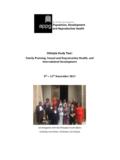Transcription of Maxims or Myths of Beauty? A Meta-Analytic and Theoretical ...
1 Psychological Bulletin Copyright 2000 by the American Psychological Association, Inc. 2000, Vol. 126, No. 3, 390-423 0033-2909/00/$ DOI: Maxims or Myths of Beauty? A Meta-Analytic and Theoretical Review Judith H. Langlois, Lisa Kalakanis, Adam J. Rubenstein, Andrea Larson, Monica HaUam, and Monica'Smoot University of Texas at Austin Common Maxims about beauty suggest that attractiveness is not important in life. In contrast, both fitness-related evolutionary theory and socialization theory suggest that attractiveness influences devel- opment and interaction. In 11 meta-analyses, the authors evaluate these contradictory claims, demon- strating that (a) raters agree about who is and is not attractive, both within and across cultures; (b) attractive children and adults are judged more positively than unattractive children and adults, even by those who know them; (c) attractive children and adults are treated more positively than unattractive children and adults, even by those who know them; and (d) attractive children and adults exhibit more positive behaviors and traits than unattractive children and adults.
2 Results are used to evaluate social and fitness-related evolutionary theories and the veracity of Maxims about beauty. I cannot say often enough how much I consider beauty a powerful and advantageous quality. Socrates called it "A short tyranny," and Plato, '~Fhe privilege of nature." We have no quality that surpasses it in credit. It holds the first place in human relations; it presents itself before the rest, seduces and prepossesses our judgment with great authority and a wondrous impression. --Montaigne, Essays "Beauty is truth, truth beauty," --that is all Ye know on earth, and all ye need to know. --Keats, Ode on a Grecian Urn Beauty has interested poets, philosophers, and scientists for centuries.
3 Indeed, the ancient Greeks believed that there is a fundamental relation between beauty and positive qualities: Those who are beautiful are also good (Sappho, Fragment No. 101). "Beauty is good" was empirically tested in a seminal study by Dion, Berscheid, and Walster (1972), who demonstrated that, even in modem times, human beings attribute positive qualities to attractive people and negative qualities to unattractive people. Since this important study, much research has focused on the effects of attractiveness, especially facial attractiveness, on, the attributions, impressions, and stereotypes of strangers. These stud- ies primarily have investigated attributions made by college stu- dents about attractive and unattractive strangers based on a pho- tograph of the face and, sometimes, minimal printed "background information" about the hypothetical individuals.
4 This stranger- attribution literature has been summarized by earlier meta-analyses Judith H. Langlois, Lisa Kalakanis, Adam J. Rubenstein, Andrea Lar- son, Monica Hallam, and Monica Smoot, Department of Psychology, University of Texas at Austin. This work was supported by a grant from the National Institute of Child Health and Human Development to Judith H. Langlois. We thank Rebecca Bigler, David Buss, David Cohen, Alan Feingold, George Holden, Don Kalick, Pam Miller, William B. Swann, and Leslie Zebrowitz for their helpful comments. Correspondence concerning this article should be addressed to Judith H. Langlois, Department of Psychology, Mezes 330/133800, University of Texas at Austin, Austin, Texas 78712.
5 Electronic mail may be sent to langlois (see, , Eagly, Ashmore, Makhijanl, & Longo, 1991; Feingold, 1992b), which have confmned the association between attractive- ness and many attributions of positive characteristics. 1 Contrary to these findings of a reliable relation between attrac- tiveness and attributions of positive qualifies, however, are several age-old Maxims and precepts holding that attractiveness either is not or should not be a significant factor in social interactions or behaviors. Three Maxims in particular are heard frequently: (a) Beauty is in the eye of the beholder, (b) never judge a book by its cover, and (c) beauty is only skin-deep. These Maxims generally reflect received wisdom about the role of attractiveness in human interaction.
6 It is curious that these Maxims are at such odds with the stranger-attribution literature. Received wisdom suggests that attractiveness is either not important at all or relevant only to first impressions but not as people become more familiar with each other. Perhaps it is the case that both are accurate: Perhaps people make attributions about strangers based on attractiveness, but there are no practical effects of being attractive or unattractive in real life. Alternatively, perhaps the attribution literature does indeed generalize to actual interactions between people who are familiar with each other. Assessing the relevance of the Maxims to every- day life and evaluating the mediating influence of familiarity on attractiveness effects are important yet unaddressed issues.
7 Beauty Is in the Eye of the Beholder Beauty is not judged objectively, but according to the beholder's estimation. --Theocritus, The Idyll According to the maxim Beauty is in the eye of the beholder, "different people have different ideas about what is beautiful" x Defining attractiveness theoretically is a topic of great interest and controversy. Until recently, empirical work proceeded without any con- ceptual or scientific definition of attractiveness: Researchers simply de- fined people as attractive when raters agreed they were attractive. Although this issue is beyond the scope of the current article, the interested reader is referred to Cunningham (1986); Farkas, Munro, and Kolar (1987); Lang- lois and Roggman ( 1990); and Langlois, Roggman, and Musselman (1994), among others.
8 390 Maxims OR Myths OF BEAUTY 391 (Spears, 1993, p. 45) and, therefore, do not agree about who is and is not attractive. Although this maxim is invoked both within and between cultures, it is believed to be true especially between cultures because different cultures presumably have very dissim- ilar standards of beauty (see, , Darwin, 1871; Ford & Beach, 1951). Assessing the veracity of this maxim is important because without consensus in judgments of attractiveness, there can be no consistent effect of attractiveness on social judgments, interac- tions, or behavior. Empirically, if beauty is only in the eye of the beholder, judgments of attractiveness should show little consis- tency among raters and, thus, low reliability coefficients.
9 Only one meta-analysis we know of has quantitatively evaluated the reli- ability coefficients of attractiveness judgments. Feingold (1992a) examined panels of raters from within the United States and Canada and found a high level of agreement among adult raters. However, we do not know of any meta-analysis that has examined reliability coefficients of attractiveness judgments made by or about children nor do we know of any meta-analysis investigating agreement across raters of different ethnicities and cultures. Never Judge a Book by Its Cover Judge not according to the 7:24 Wilkinson (1993) defined this maxim as meaning "do not judge by externals" (p. 407). The maxim urges people to disregard external appearance and to judge and treat others only on the basis of the "contents of the book.
10 " Research has yet to determine whether this maxim accurately reflects judgments and treatment of others in actual interactions or whether the maxim represents an ideal. To determine if there is adherence to this maxim, we divided and operationalized it into two components: (a) Judgments of others should not be based on their appearance, and (b) treatment of others should not be based on their appearance. If people conform to the maxim, then meta-analysis should find no signif- icant effects of attractiveness on judgments or treatment of others. Attractiveness should be particularly unlikely to influence the interactions of people who know each other because such individ- uals have more than mere external appearance on which to base their judgments.







